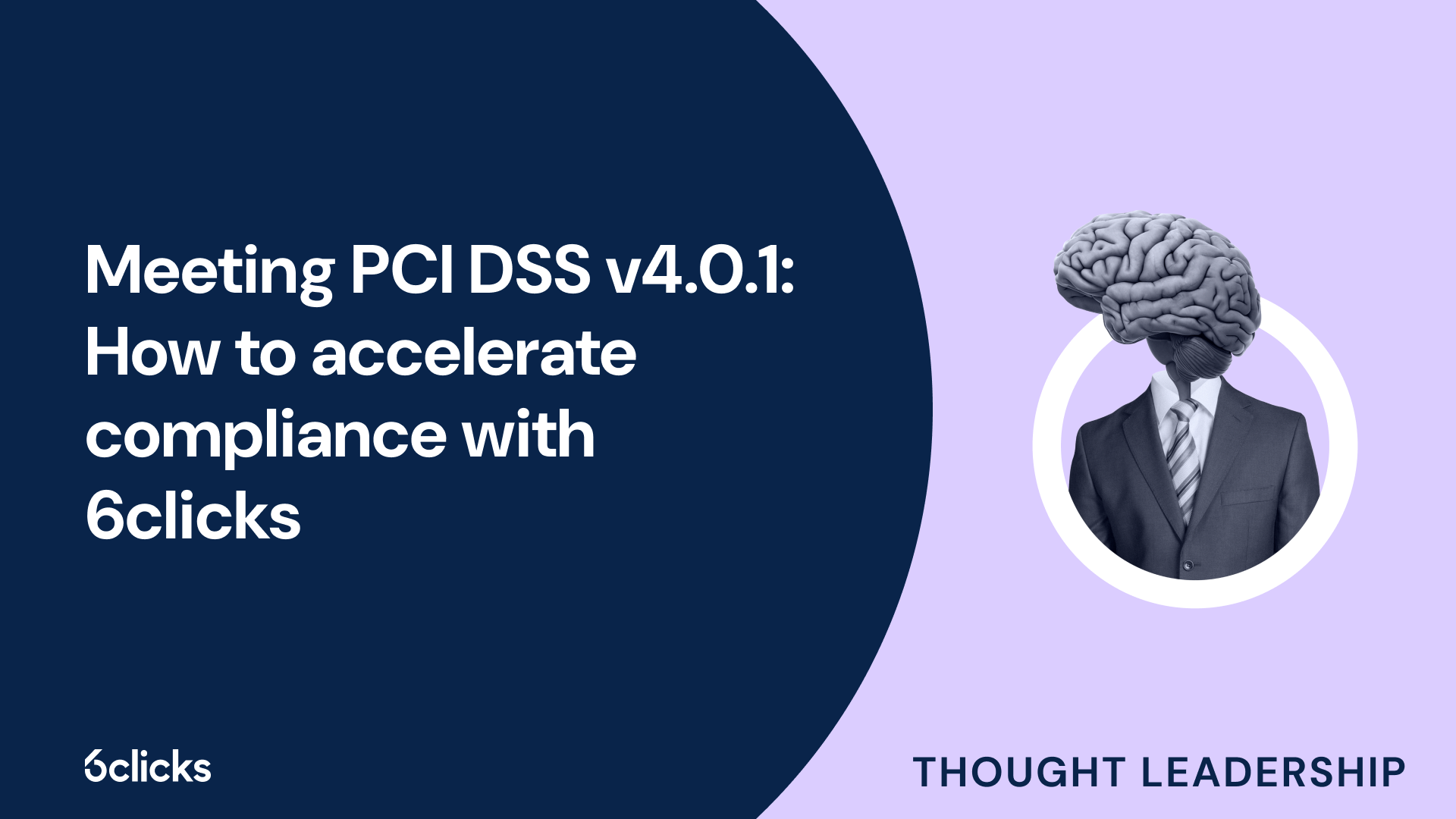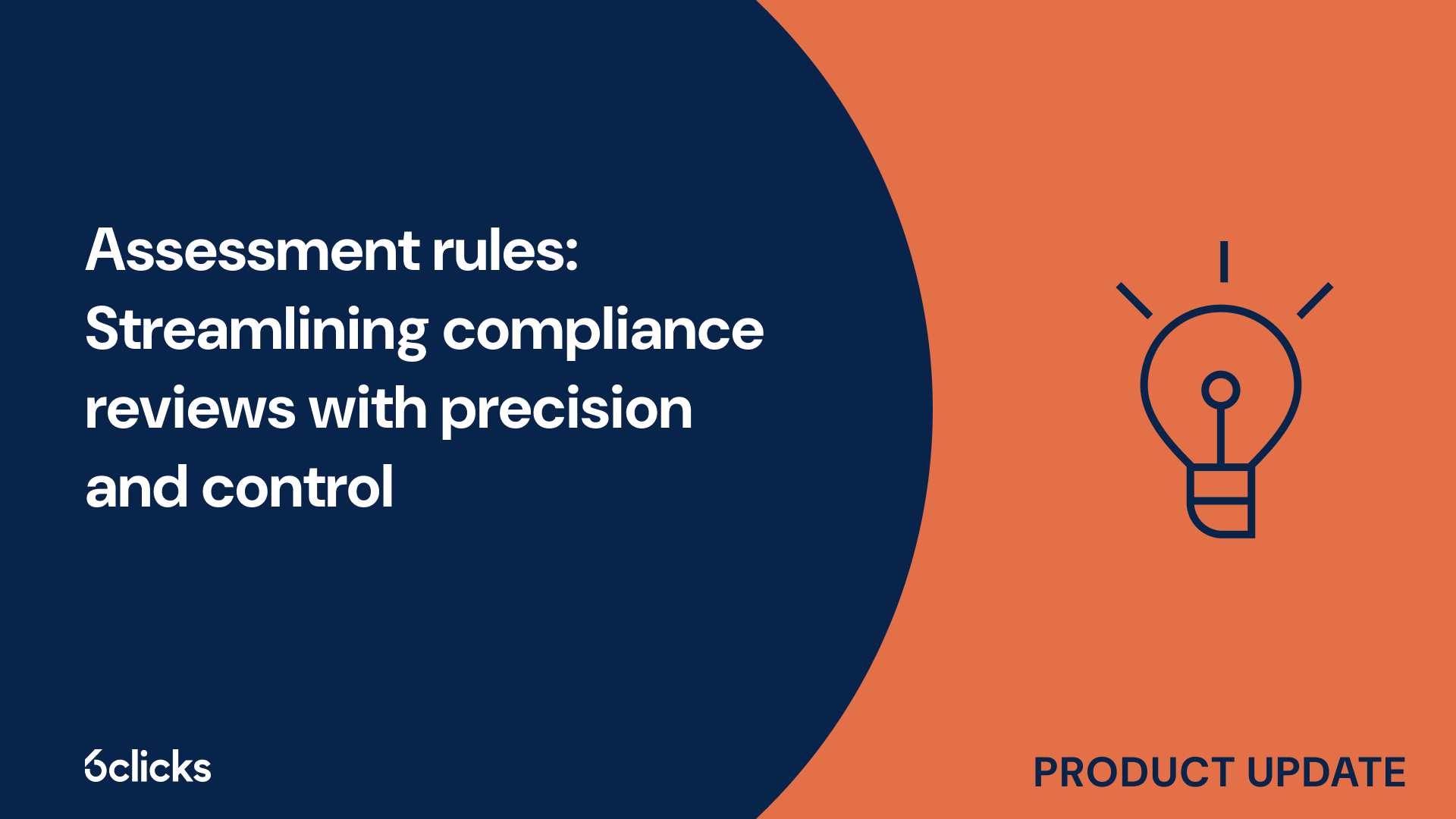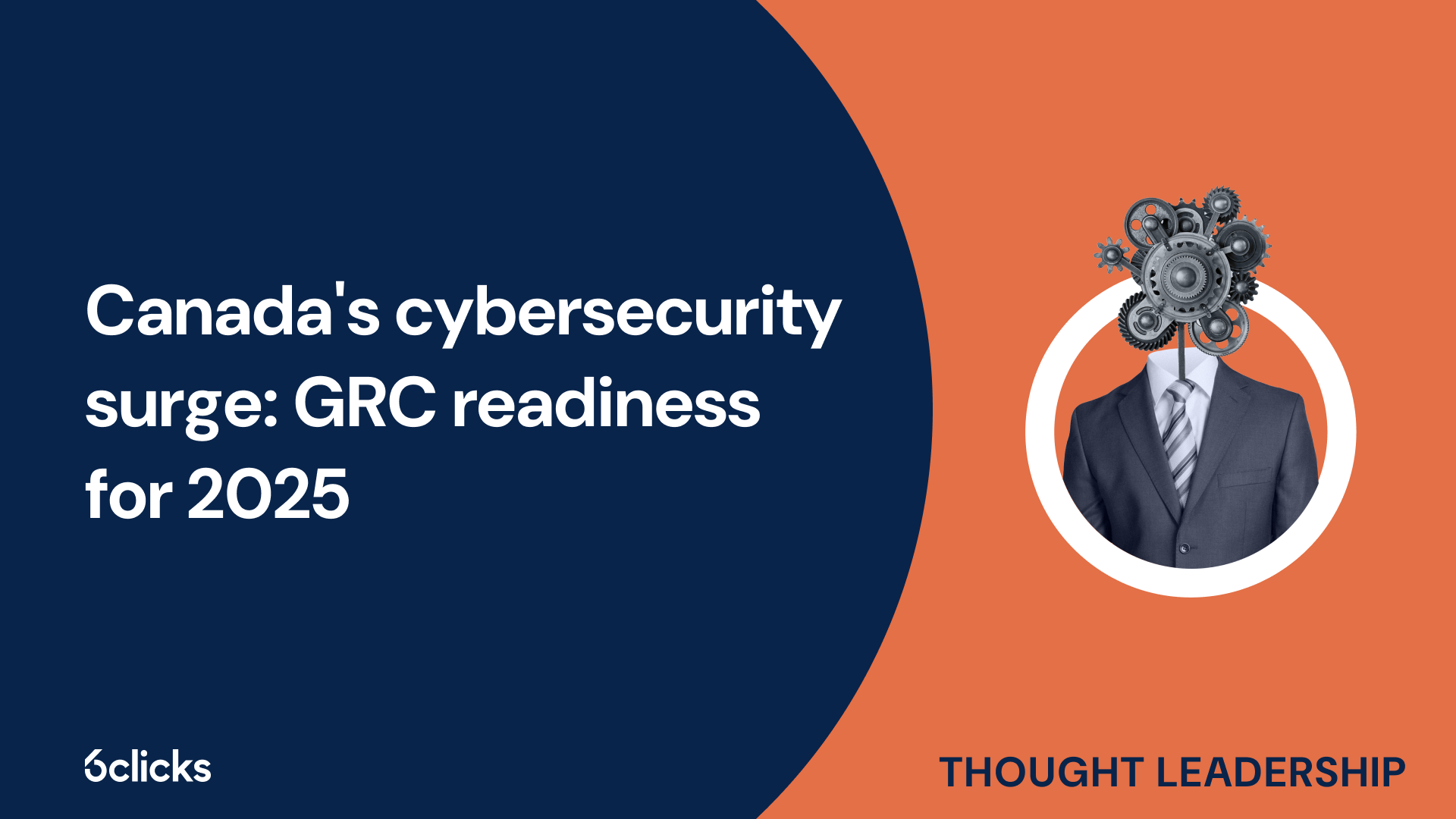The GRC buyer’s guide for 2025: Building resilience with AI-powered, federated solutions
Discover the ultimate GRC buyer's guide for 2025! Uncover how AI-powered, federated solutions transform compliance and security management for industries like government, aerospace, banking, and more. Learn about centralized control, continuous compliance, and advanced cyber GRC capabilities. Download now!
-1.png?width=200&height=249&name=Group%20193%20(1)-1.png)
The GRC buyer’s guide for 2025: Building resilience with AI-powered, federated solutions
What is enterprise risk management?
Enterprise Risk Management (ERM) is a comprehensive approach that organizations use to identify, assess, and address potential risks that could impact their operations and objectives. It provides a strategic framework for the effective management of risks, whether they are related to financial, operational, or external factors. ERM examines the entire risk landscape, considering both known and unknown risks, and helps organizations develop strategies and action plans to mitigate these risks. By implementing ERM, organizations can improve their risk profile, enhance decision-making processes, and ensure long-term sustainability in the face of uncertainty. In this article, we will explore the four pillars of enterprise risk management that form the foundation of an effective risk management system.
The four pillars of ERM
The four pillars of Enterprise Risk Management (ERM) serve as the foundation for a comprehensive risk management strategy implemented at the enterprise level. These pillars provide a structured approach to identify, assess, and respond to potential risks, ensuring that organizations can navigate uncertainty and protect their objectives.
The first pillar is risk identification and assessment. This involves the systematic identification and evaluation of risk factors that could impact the organization's ability to meet its strategic objectives. By conducting thorough risk assessments, organizations can gain a clear understanding of their risk profile and prioritize their risk management efforts.
The second pillar is risk response. Once risks have been identified and assessed, organizations must develop and implement effective strategies to manage and mitigate them. This may involve developing risk management plans, establishing internal controls, or implementing risk transfer mechanisms such as insurance.
The third pillar is control activities and monitoring. This pillar focuses on establishing and maintaining internal controls and processes to ensure that risks are effectively managed and monitored. This includes regular monitoring, testing, and reporting on the effectiveness of risk management processes.
The fourth pillar is information, communication, and reporting. Effective communication and reporting processes are vital components of an ERM system. This includes establishing clear lines of communication between the governing body, management, internal auditors, and external assurance providers. Timely and accurate reporting of risk-related information enables informed decision-making and enhances transparency within the organization.
Implementing these four pillars of ERM provides a holistic approach to risk management, ensuring that organizations can proactively identify, assess, and respond to risks while safeguarding their objectives. By integrating these pillars into their operations, organizations can build resilience and enhance their overall risk management function.
Pillar I: risk assessment
Risk assessment is a critical component of an enterprise risk management (ERM) system. This pillar involves the systematic identification and evaluation of potential risks that could impact an organization's ability to achieve its strategic objectives. By conducting thorough risk assessments, organizations can gain a clear understanding of their risk profile and prioritize their risk management efforts. This process involves analyzing various risk factors, such as operational risks, financial risks, and human error, to determine their likelihood and potential impact. It enables organizations to proactively identify and assess critical risks, allowing them to develop effective risk response strategies and allocate resources appropriately. Risk assessment is an ongoing process, requiring regular updates and review in order to adapt to changing circumstances and identify new or emerging risks. By continuously assessing and reviewing risks, organizations can enhance their ability to anticipate and navigate potential challenges, ensuring the achievement of their strategic goals in a rapidly evolving business environment.
Understanding the risks faced by the company
Understanding the risks faced by a company is a critical component of effective enterprise risk management. There are various types of risks that organizations encounter, and being aware of them is essential for developing strategies to mitigate and manage them.
Eight common types of enterprise risks include operational risks, financial risks, strategic risks, compliance risks, reputational risks, technological risks, environmental risks, and legal risks. Operational risks refer to the potential risks associated with the company's day-to-day operations, such as human error, system failures, or supply chain disruptions. Financial risks involve potential losses related to financial transactions, market fluctuations, or credit risks.
These risks can have a significant impact on the organization and its operations. Operational risks can lead to disruptions in service delivery and increased costs. Financial risks can result in significant financial loss and negatively impact the company's stability and ability to meet financial obligations. Strategic risks can hinder the achievement of business objectives and impact the company's long-term success, while compliance risks can result in legal and regulatory penalties.
Understanding these risks allows organizations to assess their risk profile and develop appropriate risk management plans. By identifying and addressing potential risks, enterprises can enhance their ability to navigate uncertainties and make informed decisions. Implementing effective risk management processes and tools is essential for mitigating the impact of these risks and promoting resilience within the organization.
Gathering information and assessing risks
Gathering information and assessing risks are essential components of enterprise risk management. This process involves collecting information about potential risks and analyzing them to determine their impact and likelihood.
To gather information about potential risks, organizations should adopt a proactive approach. This begins by identifying and documenting all possible risk factors that may impact the organization's objectives and operations. This can be done through various methods, including internal and external risk assessments, stakeholder consultations, and analysis of historical data or industry trends.
Once the information is gathered, it should be analyzed to assess the magnitude and likelihood of each risk. This entails evaluating the potential impact on the organization's objectives, financial resources, reputation, and other critical factors. Quantitative and qualitative analysis techniques can be applied to determine the level of risk exposure and prioritize risks based on their significance.
Regular assessments should be conducted at all levels of the organization to ensure comprehensive risk evaluation. This includes assessing risks at the enterprise level, business unit level, and project level. By conducting regular assessments, organizations can identify emerging risks, evaluate the effectiveness of existing risk management strategies, and adjust their approach accordingly.
Creating a risk profile
Creating a risk profile is a critical component of enterprise risk management. It involves assessing and tying potential risks back to the organization's business objectives. By doing so, organizations can gain a comprehensive understanding of the risks they face and develop effective risk management strategies.
The first step in creating a risk profile is to identify and document all potential risks that may impact the organization's objectives. This includes both internal and external risks, such as operational risks, financial risks, and compliance risks. Organizations can use various methods, including risk assessments, stakeholder consultations, and analysis of historical data or industry trends, to gather information about these risks.
Once potential risks are identified, they should be assessed in terms of their likelihood and impact. This involves evaluating how probable each risk is to occur and the potential consequences it may have on the organization's business objectives. By conducting qualitative and quantitative analysis, organizations can determine the level of risk exposure and prioritize risks based on their significance.
Regular assessments should be conducted at all levels of the enterprise to ensure comprehensive risk evaluation. This includes assessing risks at the enterprise level, business unit level, and project level. By regularly reviewing and updating the risk profile, organizations can identify emerging risks, evaluate the effectiveness of existing risk management strategies, and make necessary adjustments to their risk management approach.
Developing a response to potential risks
Developing a response to potential risks is a critical component of enterprise risk management. Once potential risks have been identified and assessed, organizations must determine how to address them effectively. This involves identifying specific risk response strategies based on the risk tolerance and risk appetite of the enterprise.
One approach to risk response is to avoid the risk altogether. This may involve changing business models, altering processes, or avoiding certain activities or partnerships that pose significant risks. Another strategy is to accept the risk, especially if the potential impact is low and the organization is willing to bear the consequences.
Organizations can also reduce the risk by implementing control measures and preventive actions. This may include enhancing internal controls, implementing safety protocols, or investing in technology or training to mitigate the occurrence or impact of potential risks.
Sharing the risk is another option, where organizations transfer the risk to a third party through insurance or contractual agreements. This can help mitigate the financial impact of risks that cannot be fully avoided or reduced.
It is essential to consider the specific potential risks listed in the risk profile to inform the development of response plans. Understanding the scope, requirements, design errors, and omissions associated with each risk can help organizations tailor their response strategies accordingly.
Developing a response to potential risks requires a thorough understanding of the organization's risk tolerance and risk appetite. By considering the potential risks and selecting appropriate response strategies, organizations can minimize the likelihood and impact of risks, protecting their objectives and promoting resilience.
Pillar II: risk control and mitigation strategies
Risk control and mitigation strategies form the second pillar of enterprise risk management. Once potential risks have been identified and assessed, organizations need to implement measures to control and mitigate those risks. This pillar focuses on putting in place controls and implementing preventive actions to minimize the occurrence or impact of potential risks. Control measures may involve enhancing internal controls, implementing safety protocols, or investing in technology or training to mitigate the occurrence or impact of risks. By proactively addressing risks through control and mitigation strategies, organizations can reduce their exposure to potential threats and enhance their overall risk management function. This pillar plays a critical role in ensuring the resilience and sustainability of enterprises, as it helps them anticipate and effectively respond to uncertainties and challenges that may arise in their business operations. By taking a proactive approach to risk management, organizations can safeguard their assets, preserve their reputation, and achieve their strategic objectives.
Establishing a risk appetite for the company
Establishing a risk appetite for a company is a crucial aspect of enterprise risk management (ERM). Risk appetite refers to the level of risk that an organization is willing to accept in order to achieve its objectives. It serves as a guide to determine the acceptable level of risk that the company is comfortable with, allowing it to make informed decisions on risks and potential rewards.
Several factors influence risk appetite. Firstly, the company's objectives play a significant role in defining its risk appetite. Different organizations have different risk-taking inclinations depending on their strategic goals, growth targets, and risk aversion. For example, a startup may be more open to taking larger risks in pursuit of rapid growth, while a more established company may have a lower risk appetite to protect its market position.
Moreover, the industry in which the company operates affects its risk appetite. Industries characterized by high volatility or regulatory uncertainties may have a higher tolerance for risk, while industries with stable demand and predictable markets may prefer a more conservative risk approach.
Lastly, risk tolerance, which represents the company's capacity to withstand potential losses, impacts risk appetite. Factors such as financial strength, available resources, and stakeholders' expectations influence a company's risk tolerance. A financially robust organization may be more willing to take on higher risks, whereas a financially constrained company may adopt a more risk-averse approach.
Aligning the risk appetite with the organization's overall business strategy is paramount. It ensures that risk management decisions are consistent with the company's vision, mission, and values. Moreover, it enables strategic risk-taking that supports the achievement of strategic objectives while considering potential negative impacts.
Developing policies and procedures to manage risk exposure
Developing policies and procedures to manage risk exposure is a crucial aspect of enterprise risk management. This process involves several key steps to ensure that risks are identified, assessed, and effectively mitigated.
The first step is to conduct a comprehensive risk assessment to identify the specific risks faced by the organization. This involves analyzing the internal environment, including the organization's business processes, systems, and operations, as well as external factors such as industry trends, regulations, and market conditions. By understanding these risks, organizations can develop strategies and controls to mitigate them effectively.
Once the risks are identified, the next step is to develop policies and procedures to manage them. These policies should outline the organization's risk management objectives, principles, and guidelines. They should clearly define roles and responsibilities, as well as the steps and processes for identifying, assessing, and addressing risks.
It is important to establish a risk appetite for the company. The risk appetite defines the level of risk that the organization is willing to tolerate in pursuit of its objectives. This involves setting boundaries and risk thresholds for various types of risks, such as operational, financial, and compliance risks. The risk appetite should align with the organization's overall business strategy and take into account factors such as risk tolerance, industry norms, and stakeholder expectations.
Implementing monitoring systems and audits is another critical component of managing risk exposure. These systems help to assess and evaluate the effectiveness of risk management policies and procedures. Regular audits ensure compliance with established risk management processes and provide insights into potential gaps or areas for improvement.
To enhance the management of risk exposure, technology solutions can be utilized. Advanced software and tools can automate risk assessment processes, capture and analyze data, and provide real-time monitoring of risks. These technologies enable organizations to identify emerging risks, improve risk visibility, and enhance decision-making for effective risk management.
By following these steps and utilizing appropriate technology solutions, organizations can develop robust policies and procedures to manage risk exposure effectively. This proactive approach enables them to identify potential risks, mitigate them, and ensure compliance with established risk management practices.
Implementing monitoring systems and audits for compliance purposes
Implementing monitoring systems and conducting regular audits are crucial for compliance purposes in enterprise risk management. These measures ensure that organizations proactively identify and address any regulatory concerns, thereby mitigating potential risks.
Monitoring systems allow organizations to track and monitor their risk management processes in real-time. By continuously monitoring risk indicators and key performance metrics, organizations can detect any deviations from established policies and procedures. This enables them to take timely corrective actions to prevent potential compliance breaches.
Audits, on the other hand, provide an independent and objective assessment of the effectiveness of the risk management program. They review the organization's risk management procedures, controls, and practices to ensure that they are consistent with regulatory requirements and industry best practices. Audits not only identify any gaps or weaknesses in the risk management framework but also provide recommendations for improvement.
By implementing monitoring systems and conducting audits, organizations demonstrate their commitment to compliance and risk management. This helps maintain stakeholder trust, satisfies regulatory requirements, and reduces the likelihood of financial penalties or legal consequences. Effective monitoring and audits ensure that the risk management program is robust, up-to-date, and aligned with industry standards, enabling organizations to navigate regulatory complexities with confidence.
Utilizing technology solutions to help manage risk exposure
Utilizing technology solutions is essential for organizations to effectively manage their risk exposure. Implementing software and tools that assist in identifying and assessing potential risks can greatly enhance an organization's risk management processes.
By integrating these technology solutions with existing risk management processes, organizations can streamline their workflows and improve overall efficiency. These solutions can automate manual tasks, such as data collection and analysis, reducing the likelihood of human error and ensuring accuracy in risk assessments.
Technology solutions also provide real-time monitoring capabilities, enabling organizations to track risk indicators and key performance metrics in a timely manner. This allows for early detection of potential risks and deviations from established policies or procedures, allowing organizations to take prompt action and prevent or mitigate potential negative impacts.
Furthermore, these solutions enhance reporting capabilities by providing comprehensive and accurate data visualization, making it easier for decision-makers to understand and communicate risk information effectively. This not only helps in proactive decision-making but also facilitates transparency and accountability within the organization.
Pillar III: risk communication and reporting
Effective risk communication and reporting are critical components of enterprise risk management. This pillar focuses on ensuring that risk information is effectively communicated throughout the organization, enabling decision-makers to make informed choices. It includes mechanisms for reporting, documenting, and disseminating risk assessments, risk profiles, and risk response strategies. By implementing clear and concise communication processes, organizations can ensure that key stakeholders are aware of potential risks and understand the actions being taken to address them. This pillar also emphasizes the importance of regular reporting on risk management activities, providing transparency and accountability. Robust communication and reporting frameworks enable organizations to monitor their risk exposure, evaluate the effectiveness of risk management strategies, and make necessary adjustments when required. They help create a risk-aware culture within the organization and foster a proactive approach to risk management. With effective risk communication and reporting, organizations can enhance their decision-making processes and effectively respond to potential risks, ultimately safeguarding their business operations and achieving their objectives.
Establishing open lines of communication about risk issues throughout the organization
Establishing open lines of communication about risk issues throughout an organization is crucial for effective enterprise risk management. By promoting a culture of transparency and accountability, organizations can encourage employees at all levels to report potential risks and create an environment where risk-related discussions are encouraged.
To promote open communication, organizations should create channels for employees to report any potential risks they encounter. This can be done through a dedicated reporting platform or by providing anonymous reporting options. Employees should feel empowered to speak up about any concerns they have regarding risks that may affect the organization.
Regular meetings or workshops focused on risk-related topics can also help foster open communication. These meetings allow different departments to share their challenges and experiences related to risk management. By creating a forum for discussion and collaboration, organizations can identify and address potential risks more effectively.
Transparency and accountability are key in establishing open lines of communication. Organizations should emphasize the importance of reporting risks and the role each employee plays in mitigating them. By promoting a culture in which risk reporting is valued and rewarded, organizations can proactively address potential risks and enhance their risk management processes.
Developing standardized reports on key risks faced by the organization
Developing standardized reports on key risks faced by the organization is a critical component of effective risk management. These reports provide a comprehensive and structured overview of the potential risks that the organization may encounter.
The process of developing standardized reports begins with a thorough risk assessment. This involves identifying and analyzing the various risks that the organization may face, considering both internal and external factors. By conducting a comprehensive risk assessment, organizations can gain a clear understanding of their risk profile and prioritize the risks that pose the greatest threat.
Once the risks have been identified, they are categorized and evaluated based on their potential impact and likelihood of occurrence. This helps in determining the level of risk exposure and allows the organization to focus on mitigating the most critical risks.
Standardized reports on key risks provide a centralized and easily accessible platform for tracking and addressing potential risks. These reports highlight the identified risks, their likelihood and impact, and the necessary risk response strategies. They serve as a reference point for decision-makers, enabling them to allocate resources and implement appropriate risk management measures.
By regularly updating and reviewing these reports, organizations can monitor the effectiveness of their risk management actions and make necessary adjustments. This proactive approach to risk management not only helps in minimizing potential losses but also aids in improving project profitability and protecting the organization from liability.







